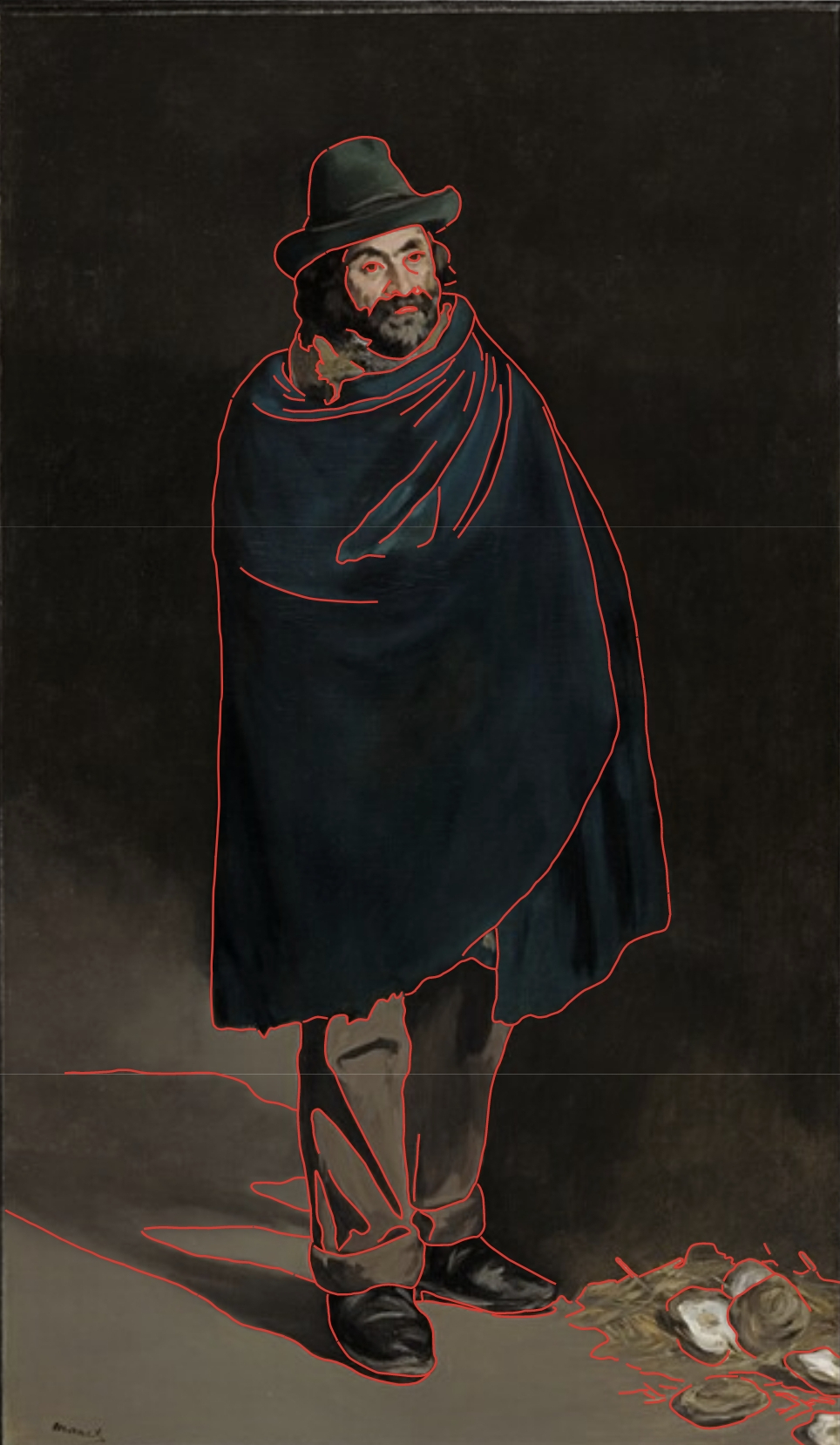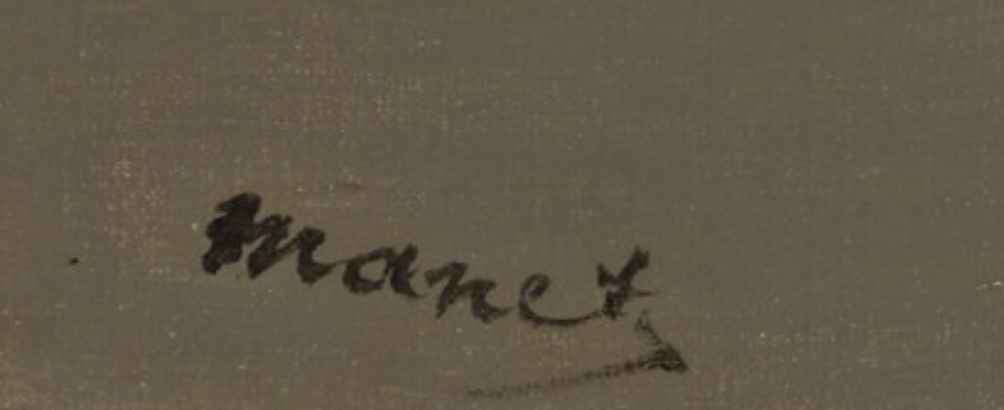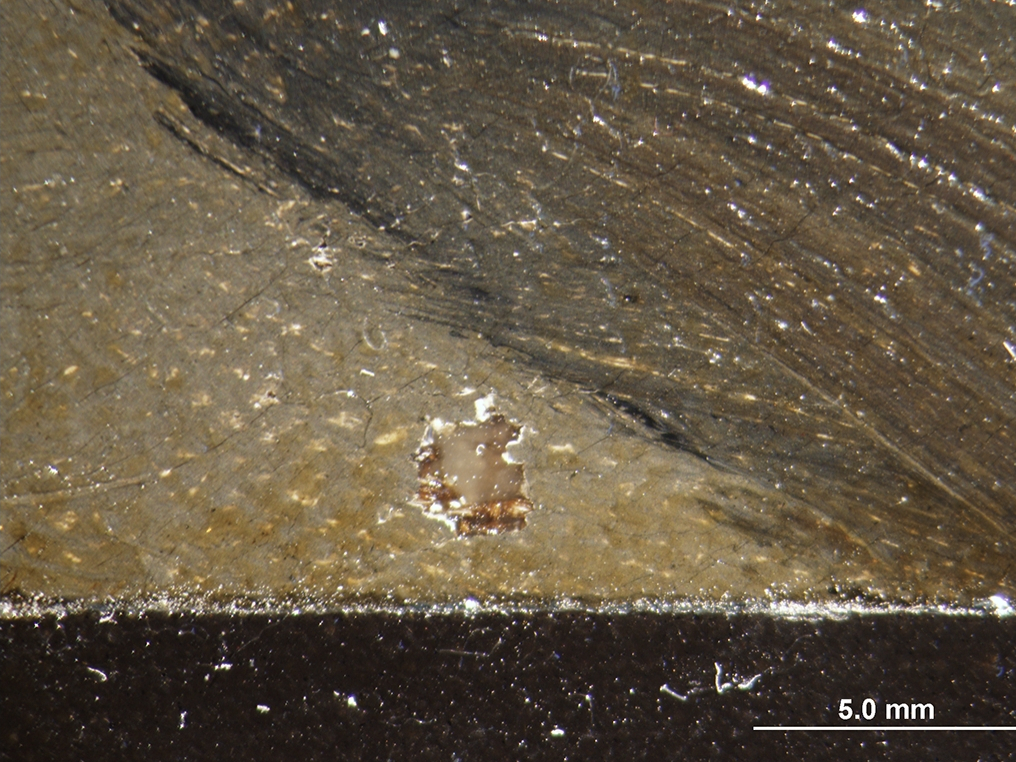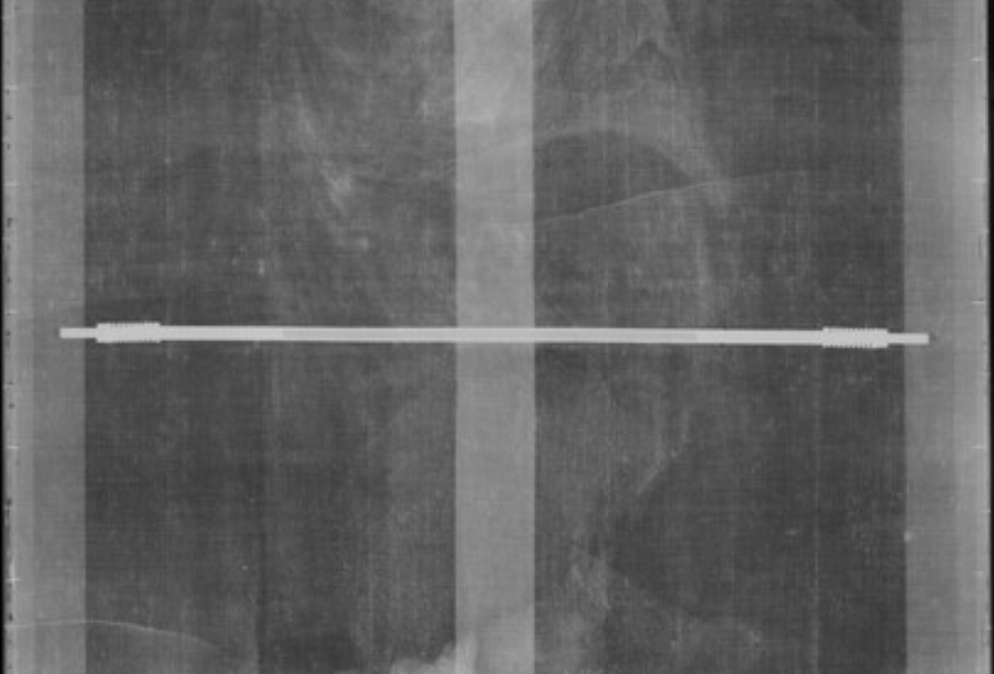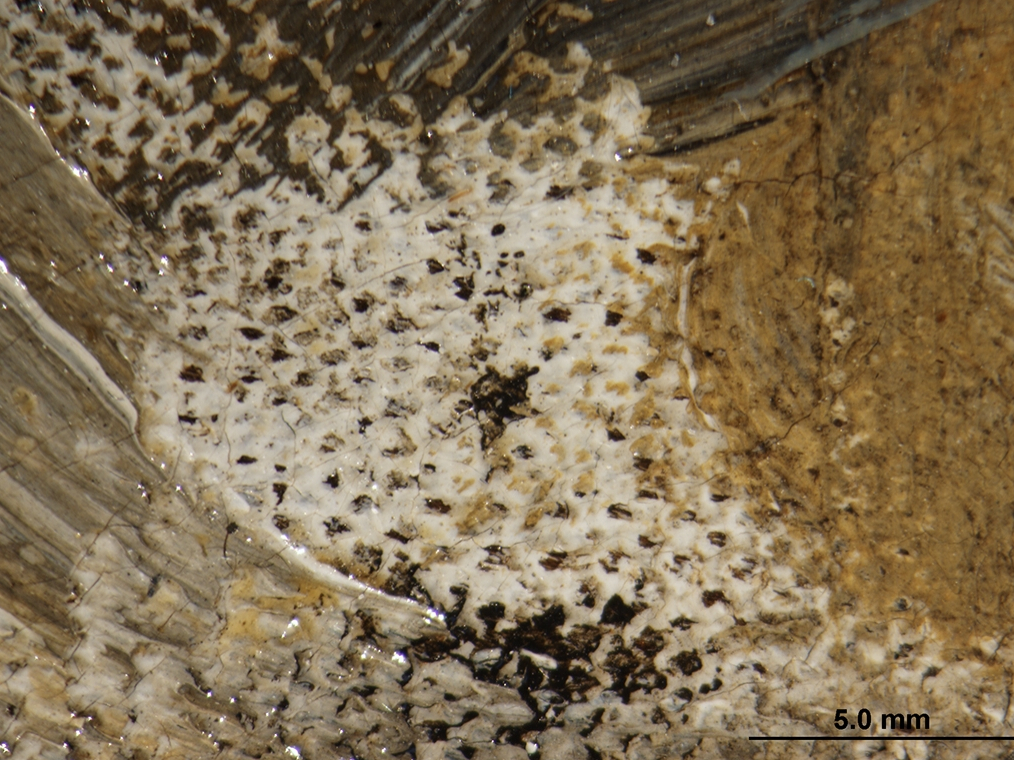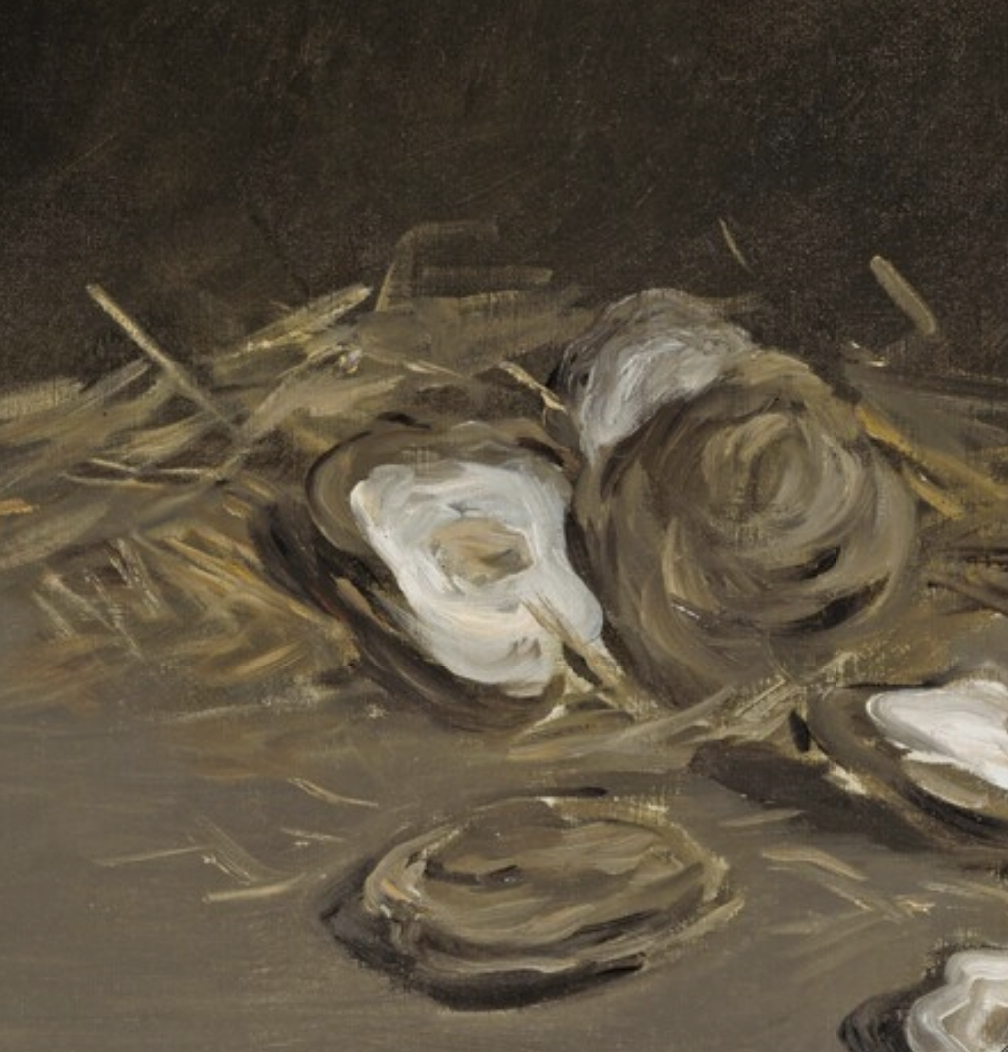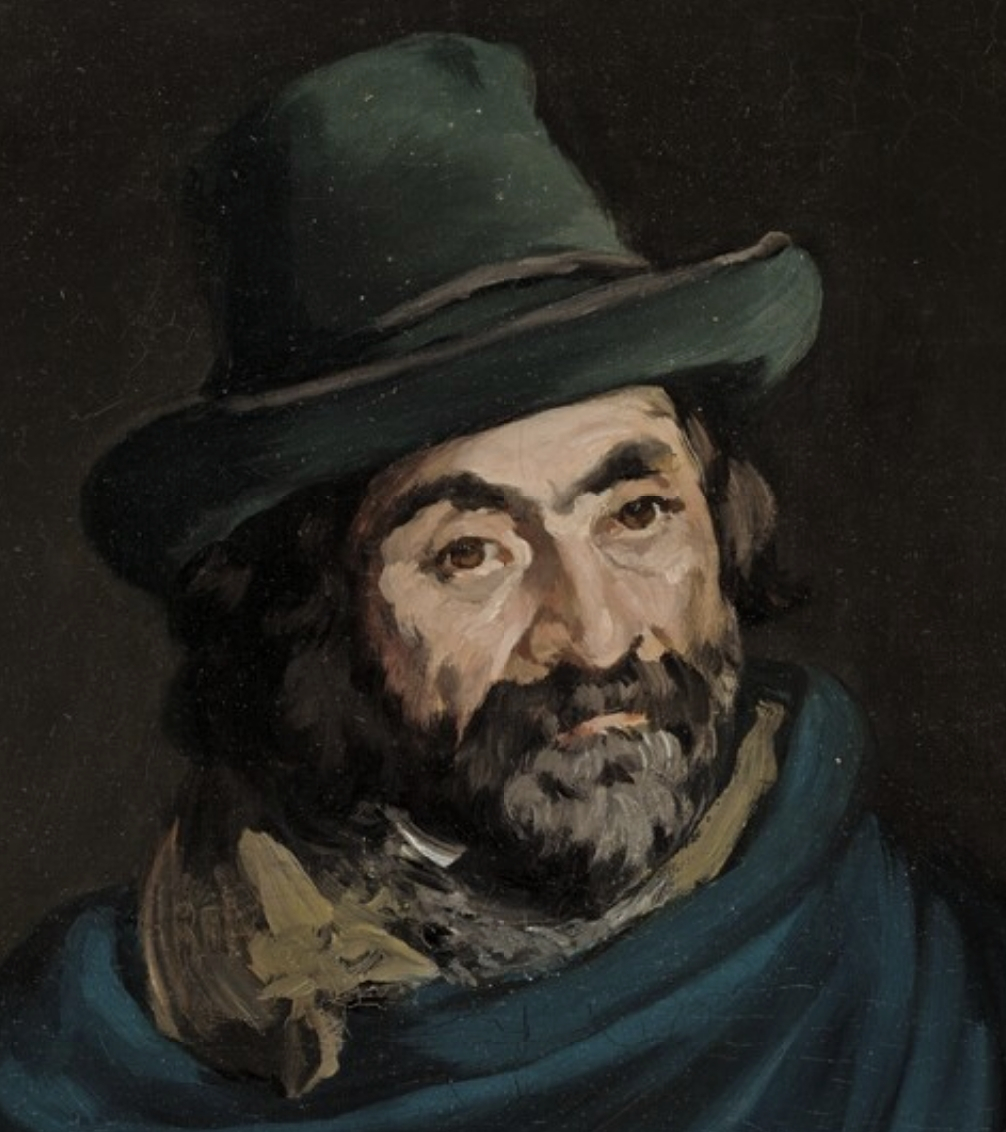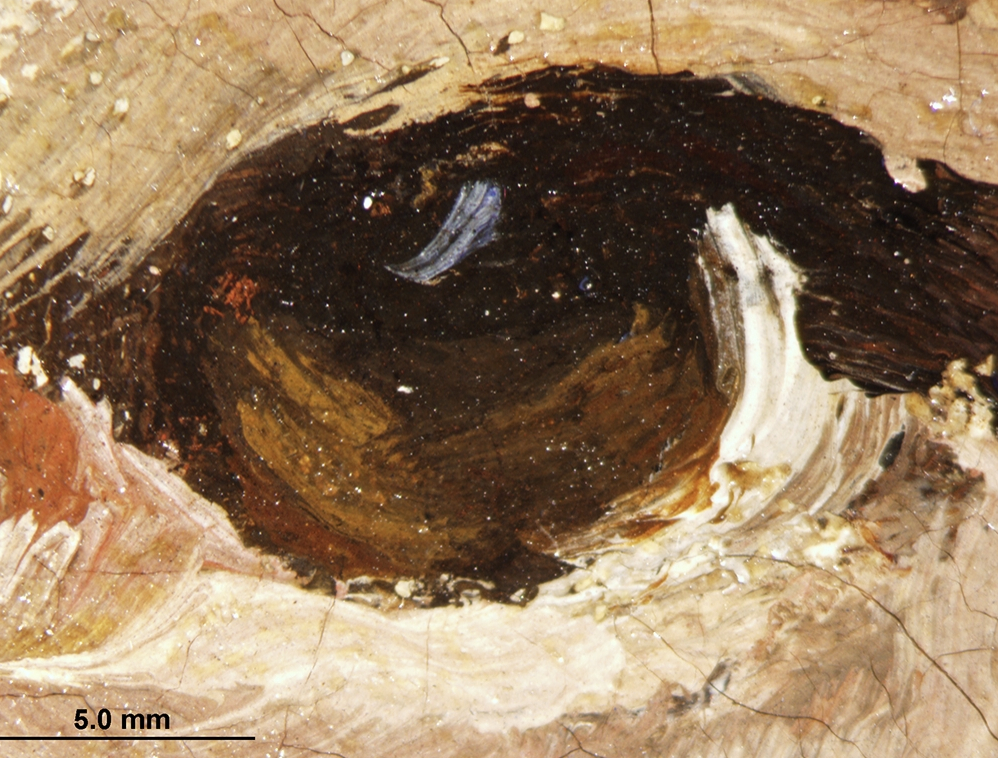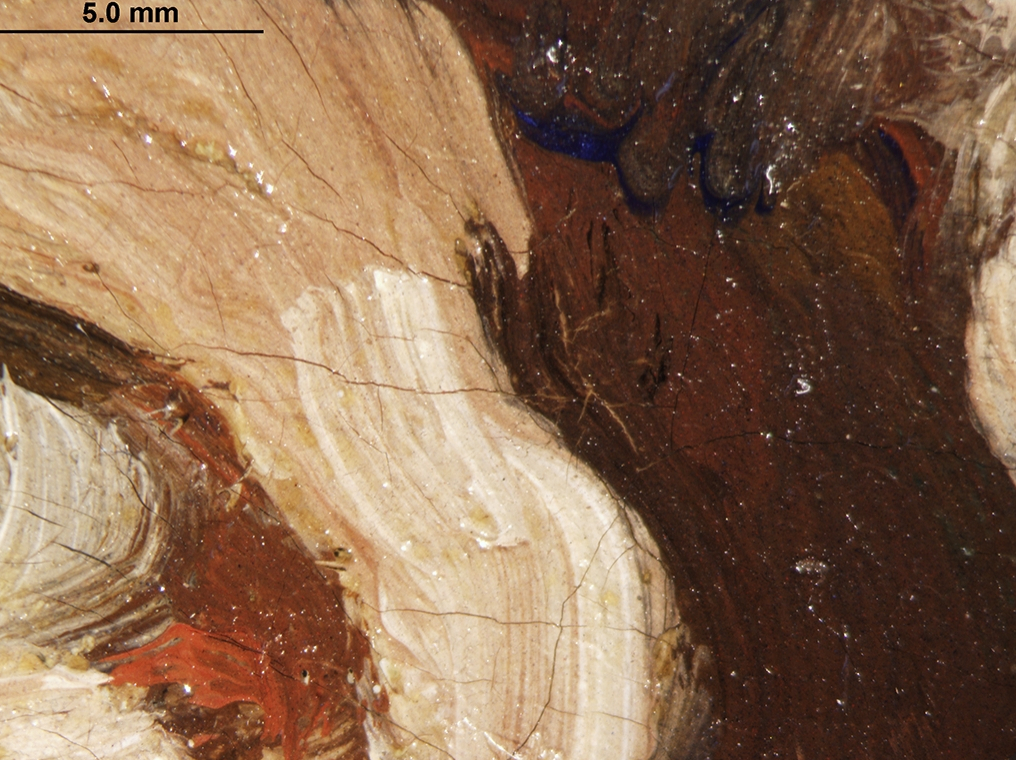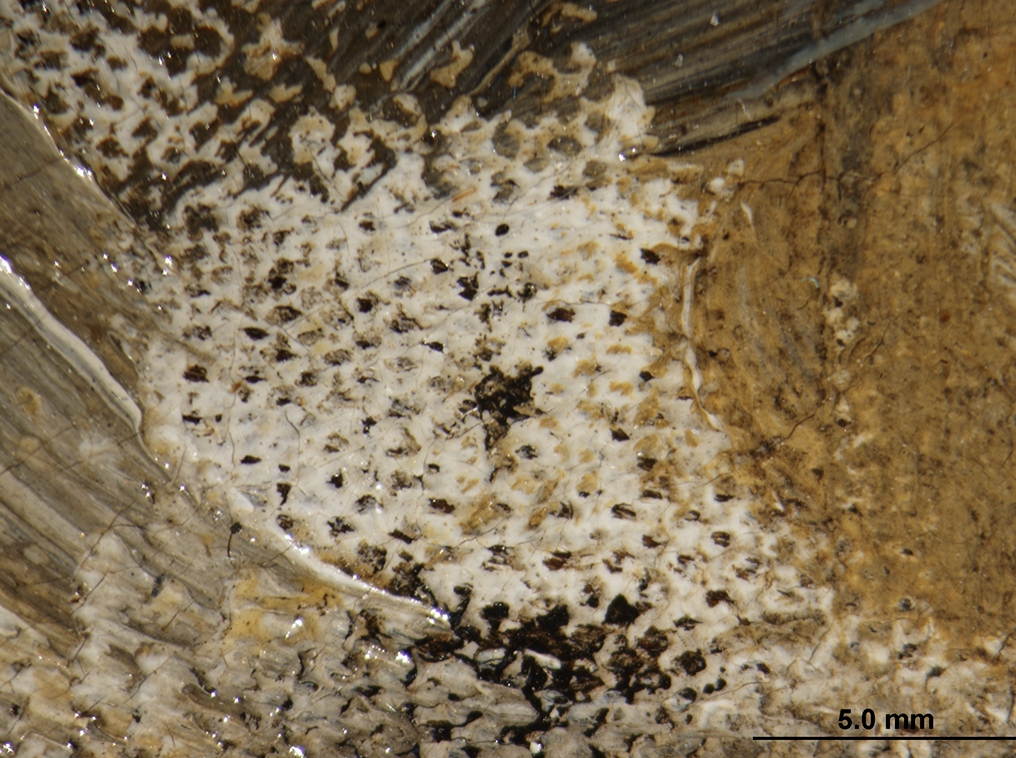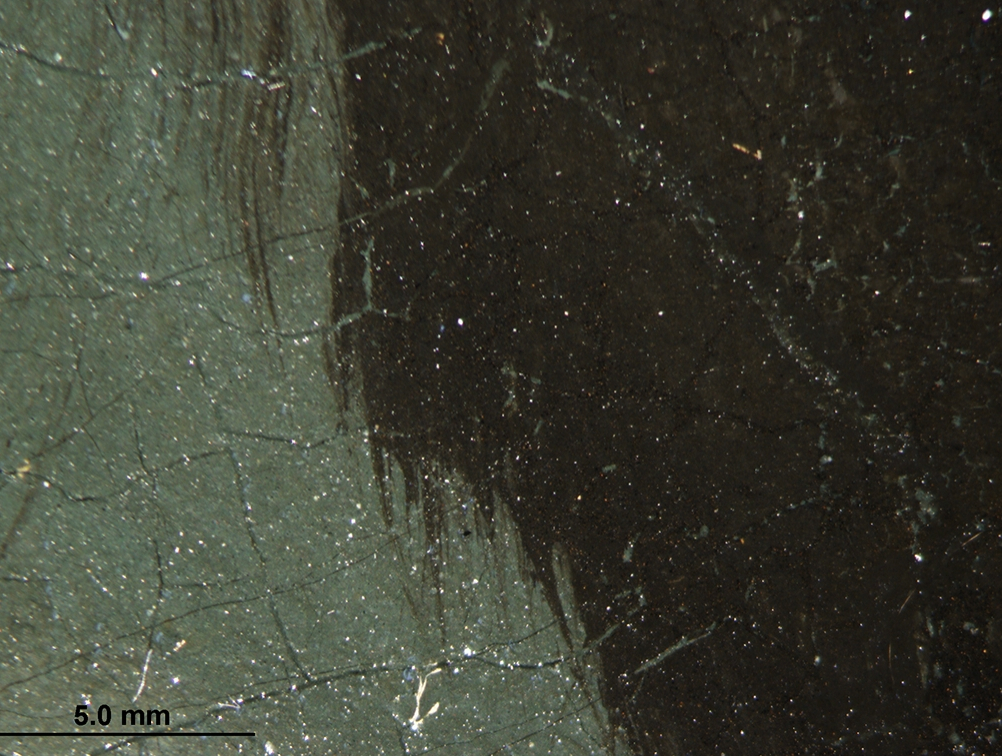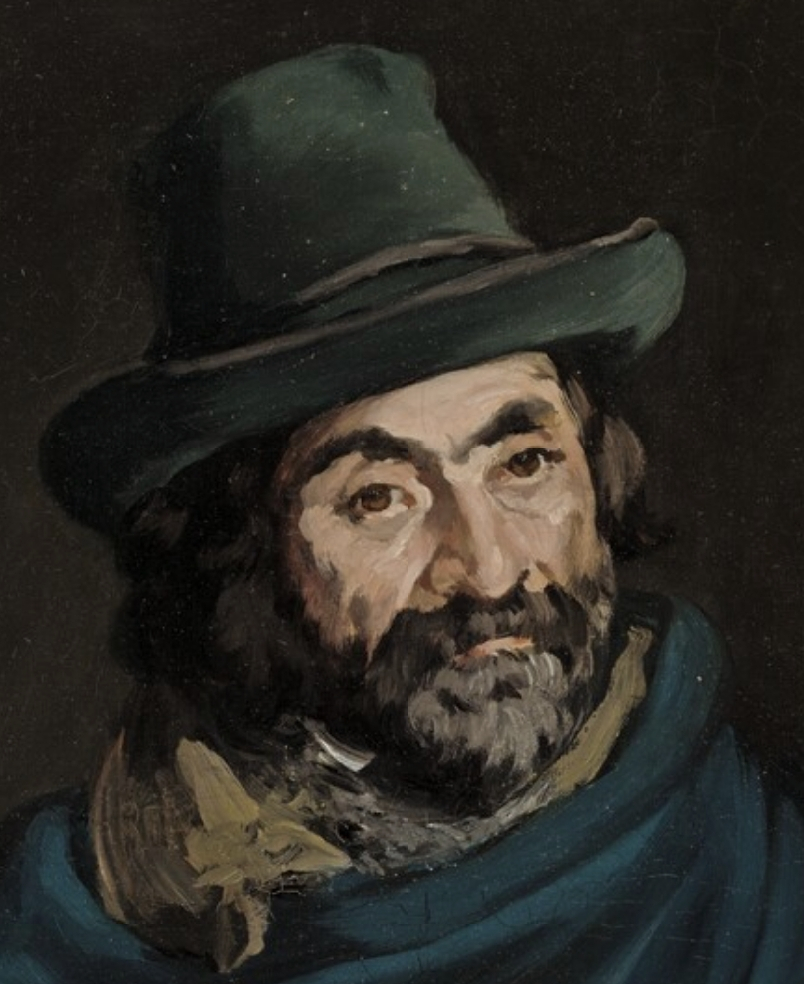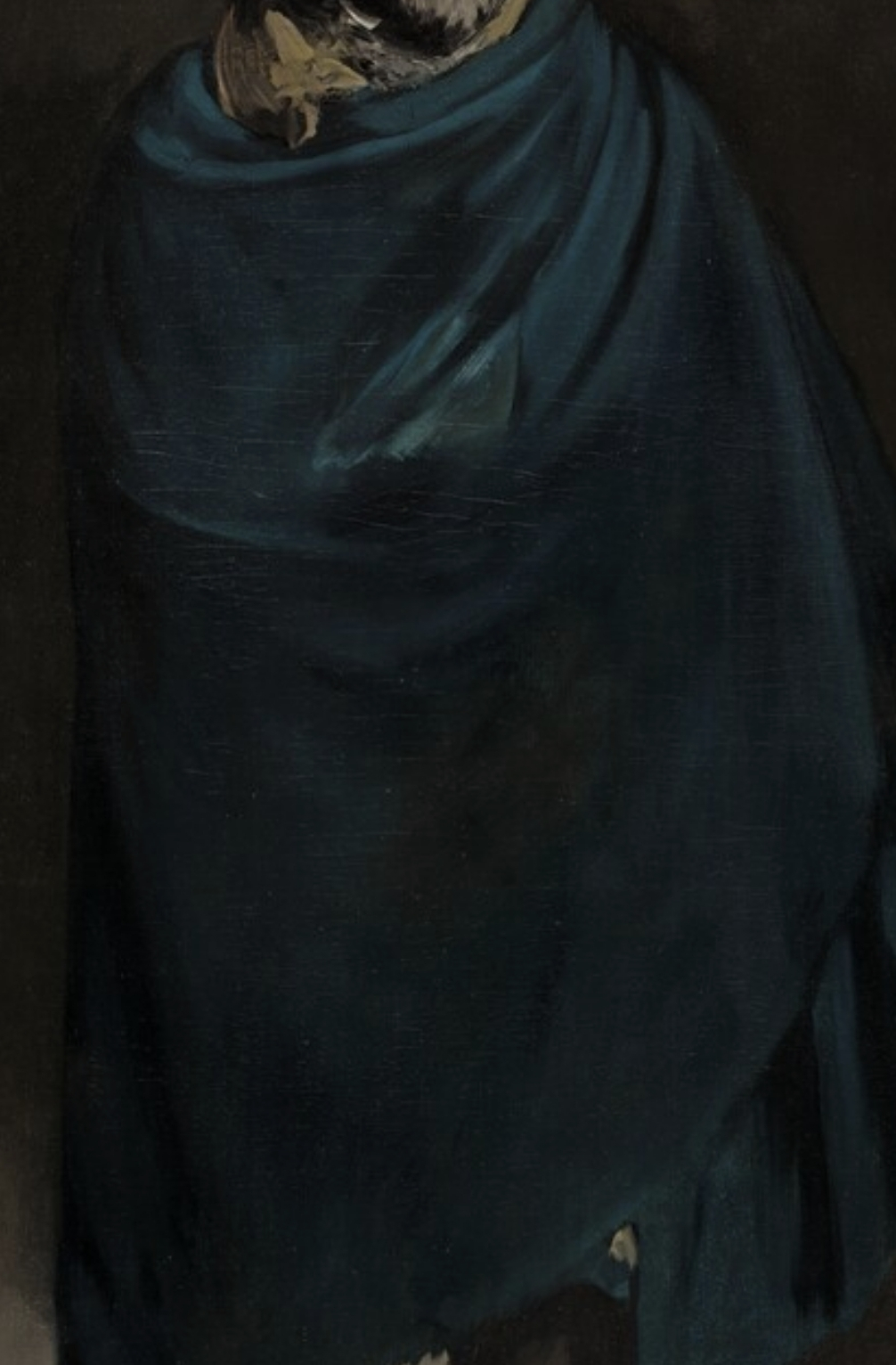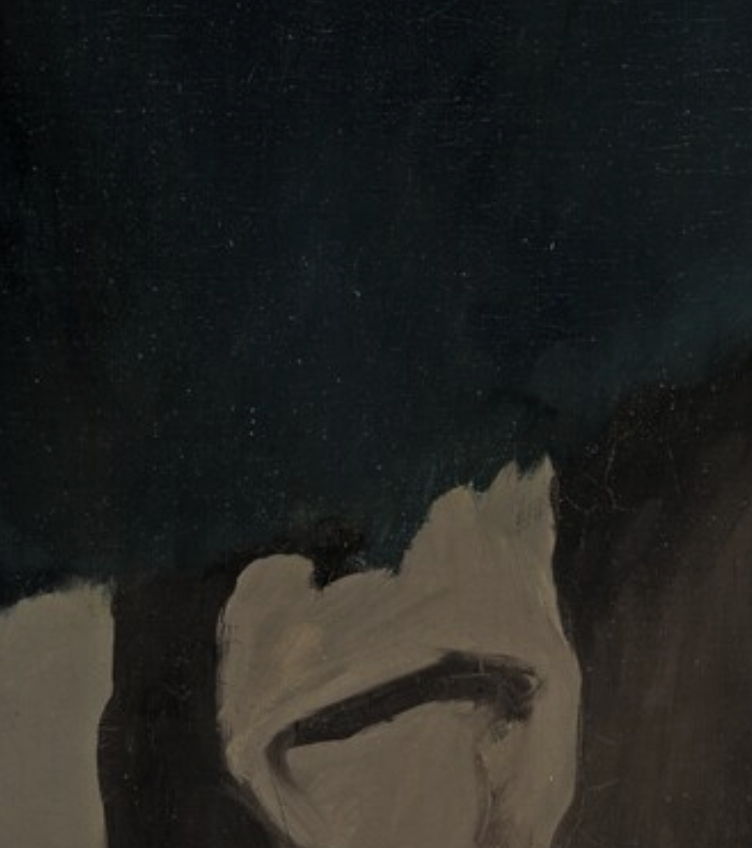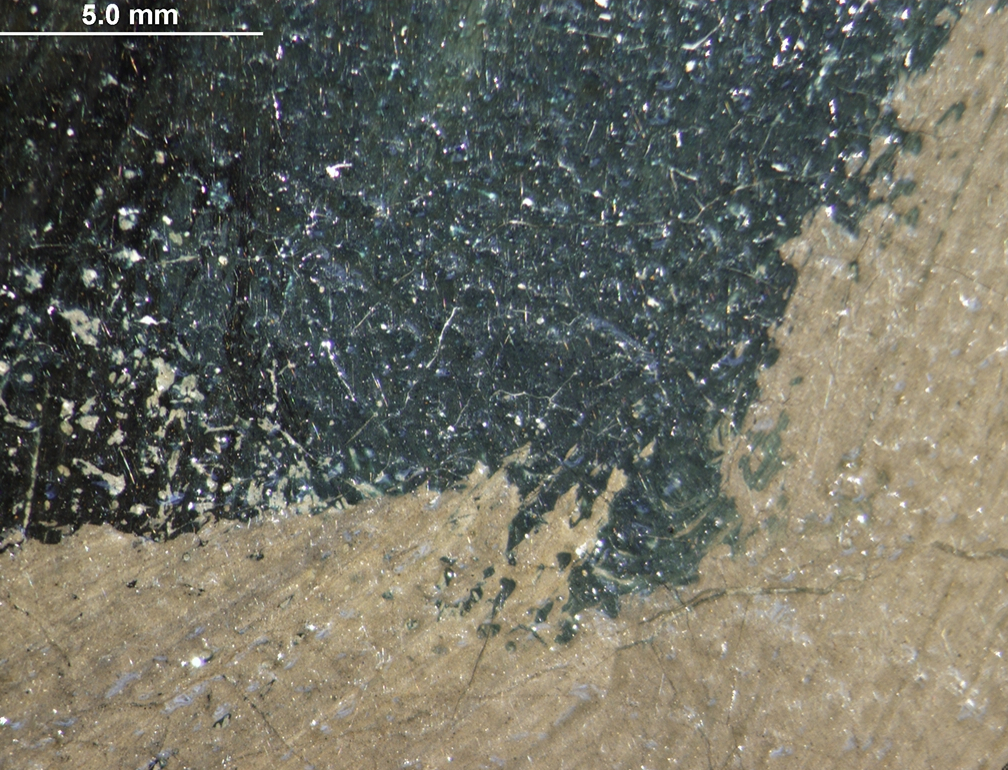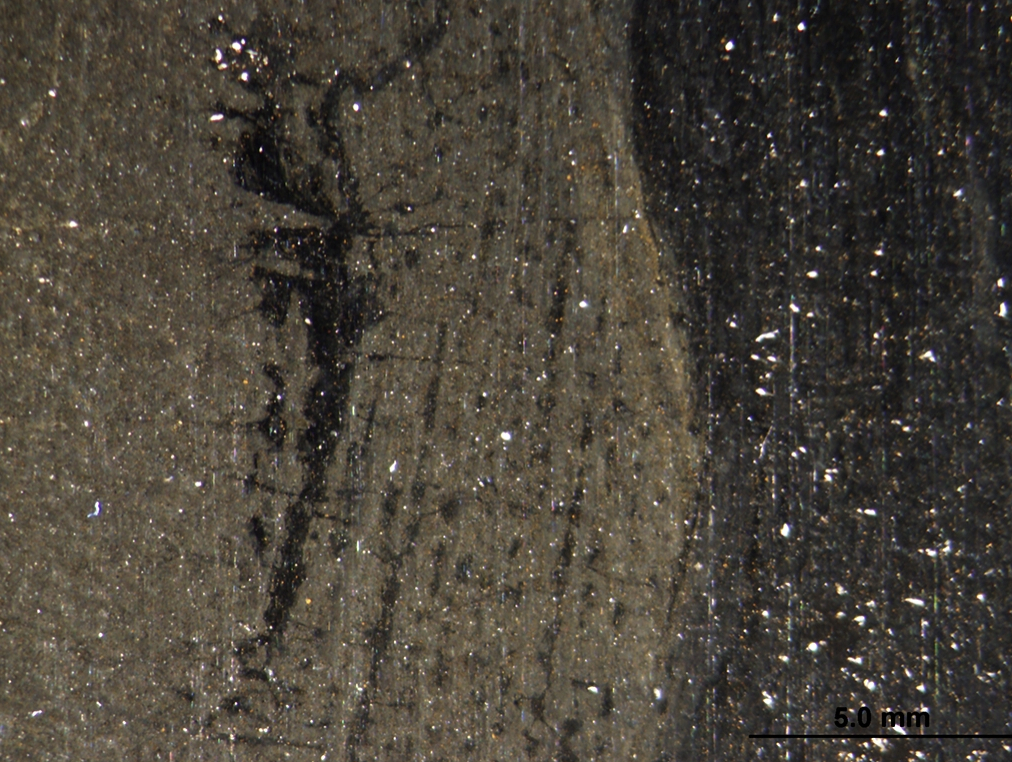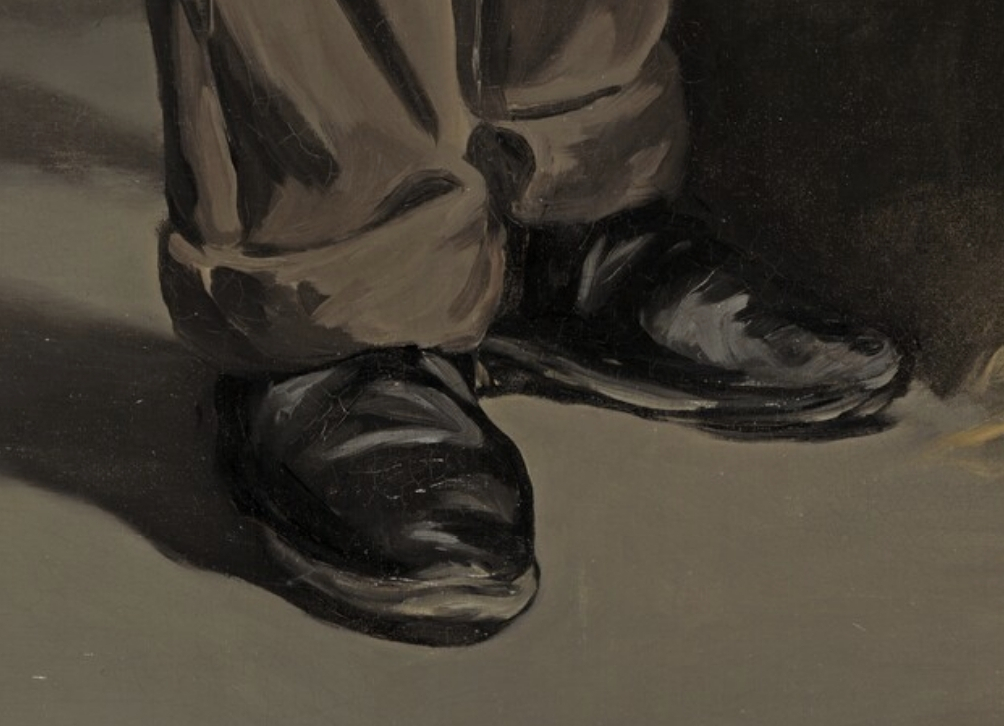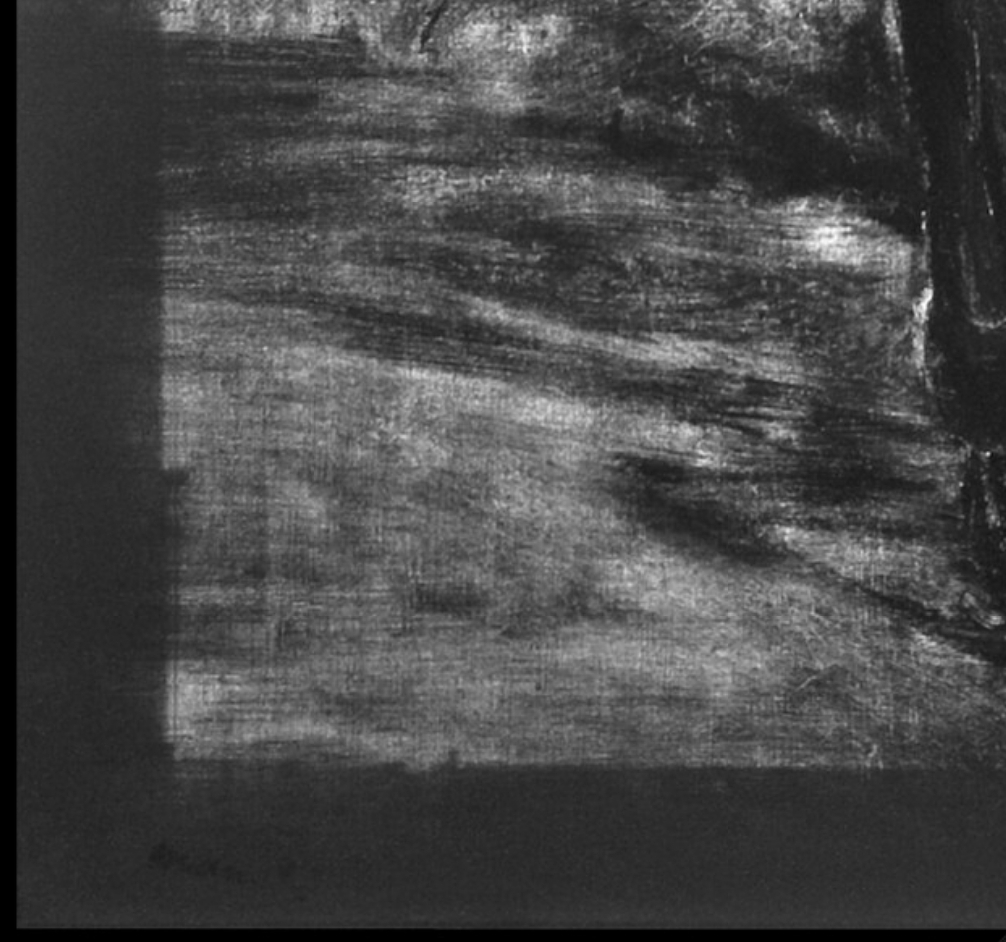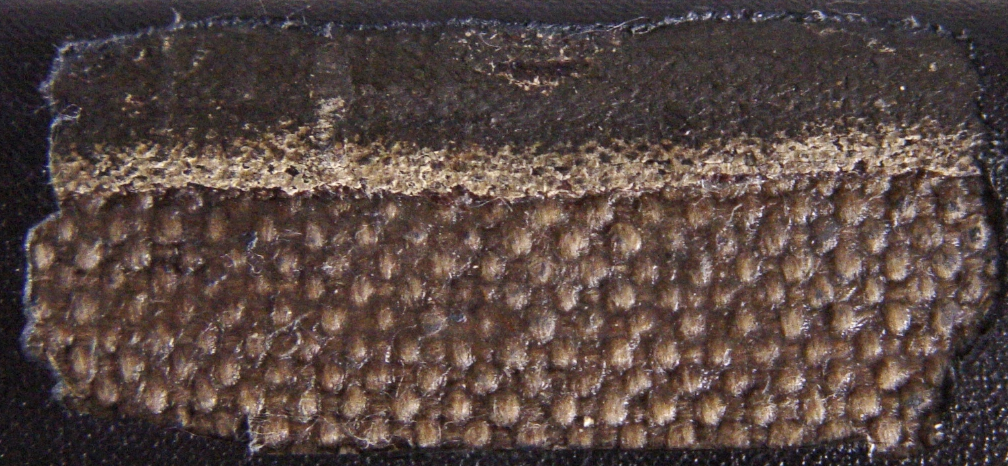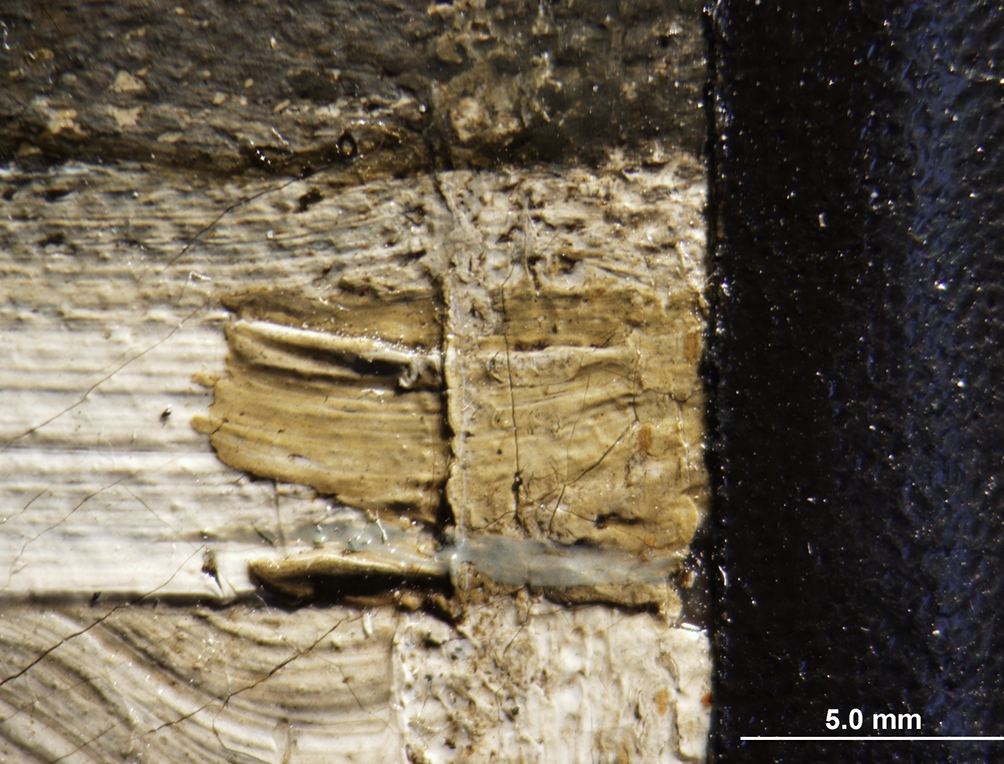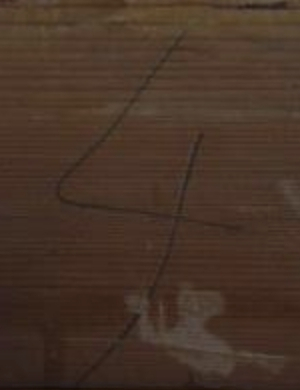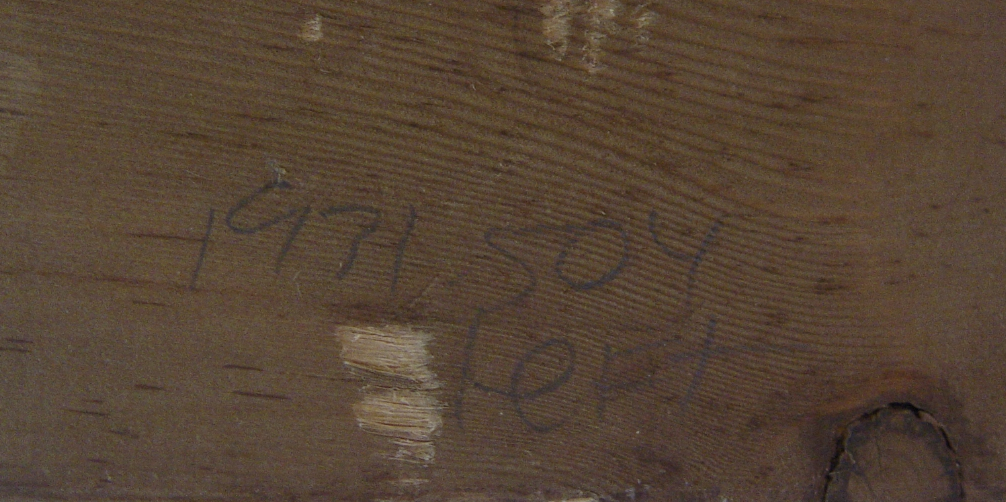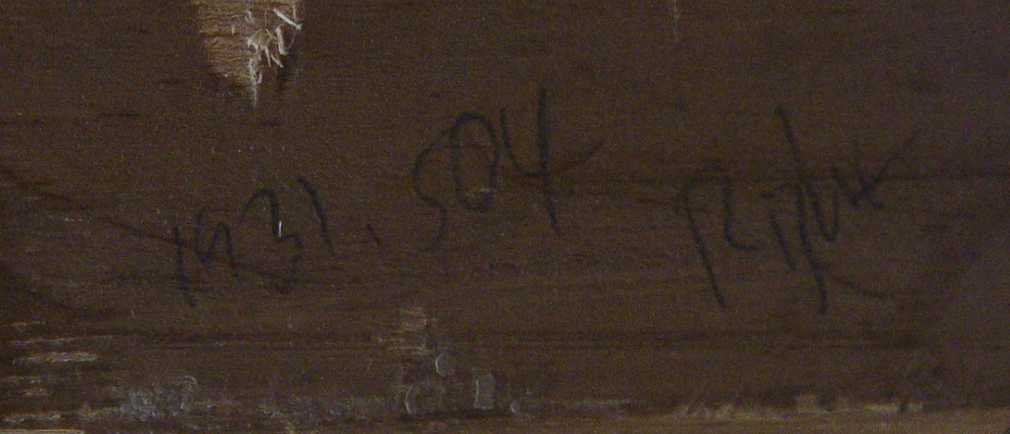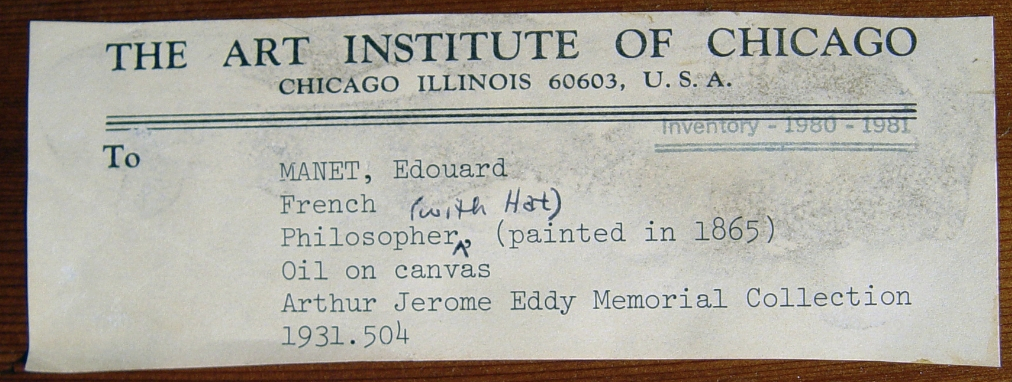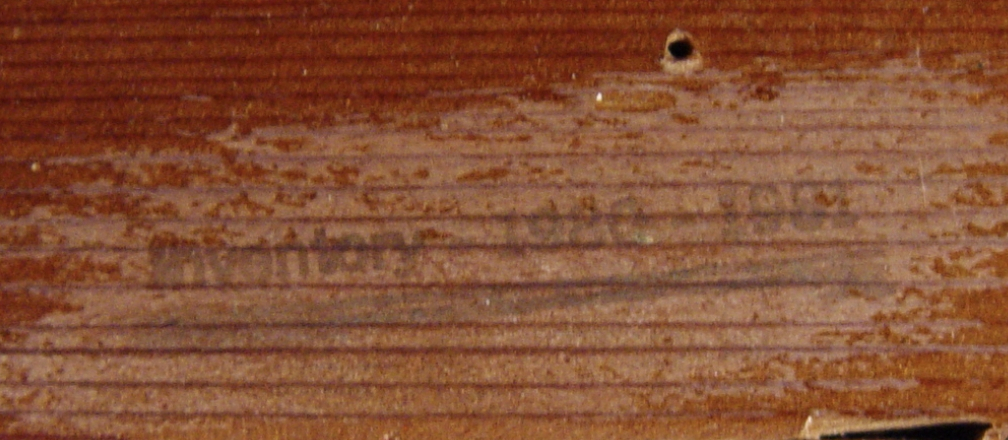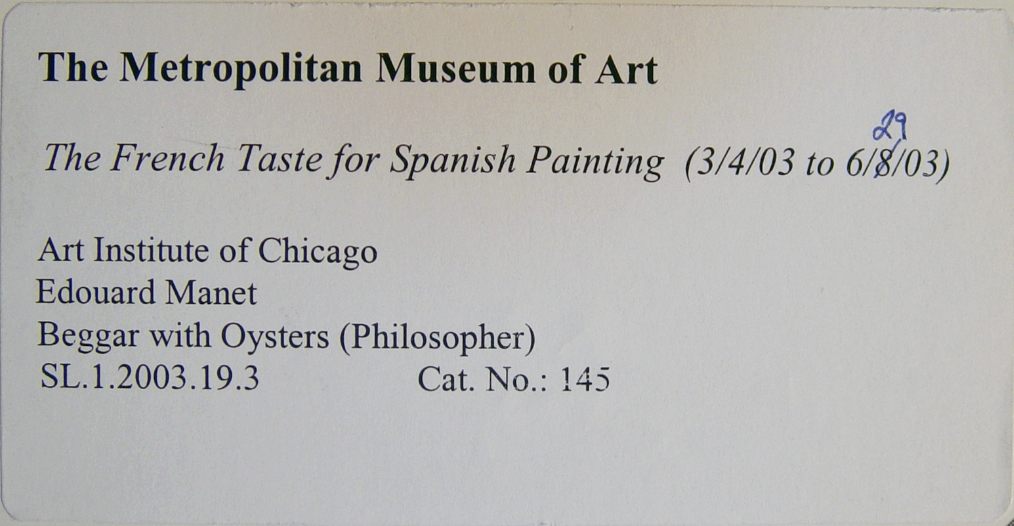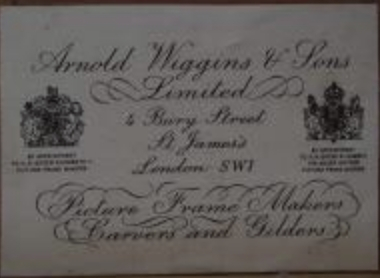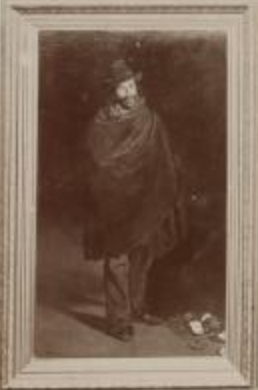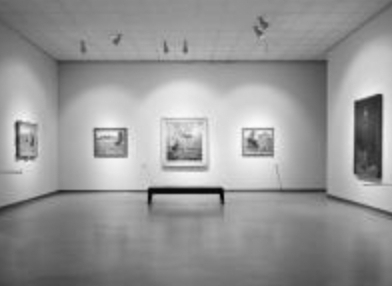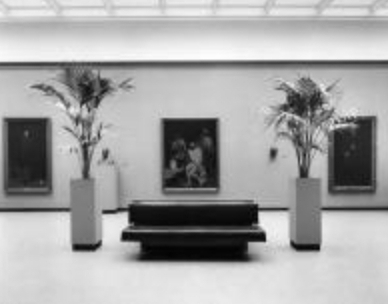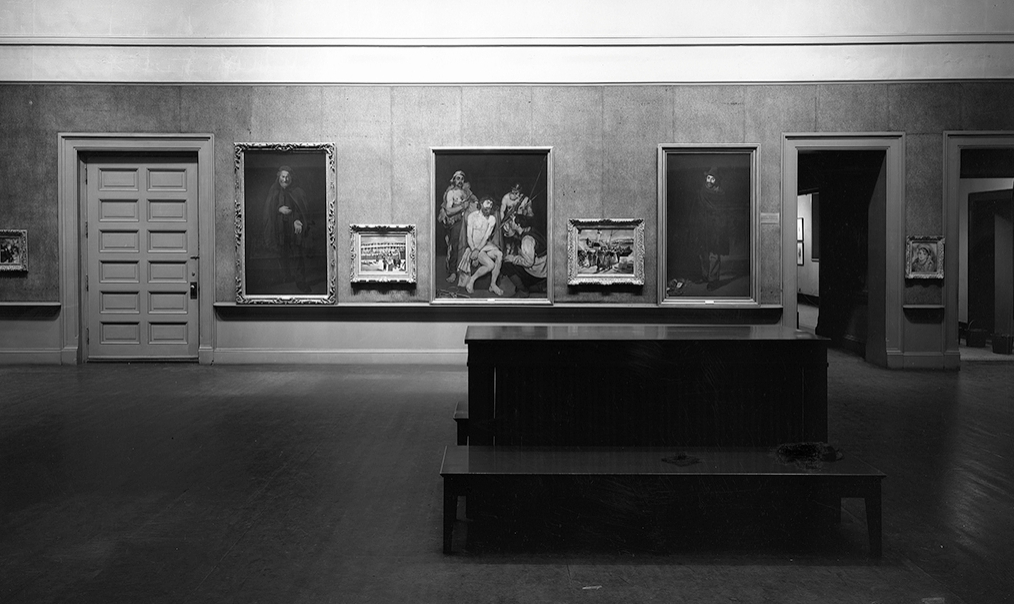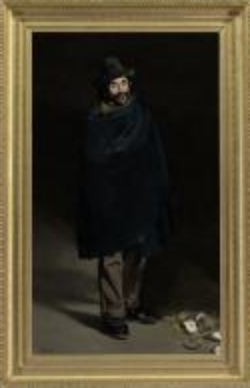Technical Report
Technical Summary
Édouard Manet’s Beggar with Oysters (Philosopher) was painted on a pre-primed, plain-weave, non-standard-size canvas. The off-white ground consists of a single layer. The appearance in the X-ray of small pinholes located close to the foldover on each side may indicate that the canvas was pinned flat for the execution of the painting. Manet carried out the work in multiple sessions, making small changes and reworking several areas of the figure in the process. It appears that the artist scraped or abraded some of the earlier paint layers as he worked up the composition. Manet applied the paint in smooth, broad brushstrokes throughout the background and in the blue cloak, applying more textural brushwork locally in the face and the oysters. The fact that dark-brown paint from the background of the composition extends onto the top and bottom tacking margins suggests that Manet made small adjustments to the painting’s overall dimensions when he stretched the canvas.
Multilayer Interactive Image
The multilayer interactive image viewer is designed to facilitate the viewer’s exploration and comparison of the technical images (fig. 10.1).
Signature
Signature/Stamp
Signed: Manet (lower left corner, in dark-brown paint) (fig. 10.2). The underlying paint was dry when the signature was applied.
Structure and Technique
Canvas
Linen (estimated).
Standard format
The dimensions do not correspond to a standard size. The support was probably custom ordered or possibly cut from a roll of canvas and stretched in the studio.
Weave
Plain weave. Average thread count (standard deviation): 16.4V (1.0) × 22.5H (0.6) threads/cm. The horizontal threads were determined to correspond to the warp and the vertical threads to the weft. No weave matches were found with other Manet paintings analyzed for this project.
Canvas characteristics
Cusping is present on all four sides. The cusping is strongest along the top edge.
Stretching
Current stretching: Dates to 1961–62 conservation treatment (see Conservation History); tacks spaced 5–11 cm apart.
Original stretching: Old tack holes spaced approximately 2–7 cm apart. More than one set of tack holes may be present. The cusping does not always seem to correspond to the placement of the old tack holes. The X-ray appears to show a series of small holes inside or close to the foldover on each side that could relate to an earlier tacking of the canvas if, for example, the canvas was pinned onto a flat surface for execution and then stretched. The holes, however, are currently covered by the black tape applied to the edges after the 1961–62 conservation treatment (see Conservation History); one hole remains visible in the lower right corner (fig. 10.3).
Stretcher/strainer
Current stretcher: Dates to 1961–62 conservation treatment (see Conservation History). ICA redwood spring stretcher with vertical wooden crossbar and horizontal metal crossbar. Depth: 3.5 cm.
Original stretcher: Discarded. The previous stretcher may have been the original stretcher. It was documented as a six-membered stretcher with a vertical and a horizontal crossbar; not mitred.
Manufacturer’s/supplier’s marks
None observed in current examination or documented in previous examinations.
Preparatory Layers
Sizing
Not determined (probably glue).
Ground application/texture
It was not possible to observe all of the original tacking margins as they are partly covered by black adhesive tape that was applied to the edges after the 1962 lining (see Conservation History). A small section of the tape was removed on each side, in areas where the tacking edges appeared to be widest. In all of these areas, the ground extends to the cut edge of the canvas (fig. 10.4). This suggests that the canvas was cut from a larger piece of primed fabric. Sweeping strokes visible in the X-ray appear to be related to slight differences in thickness of the ground layer resulting from the application technique (fig. 10.5). It appears that a rigid implement, such as a large spatula, was used to smooth the surface of the ground layer, creating some ridges that are visible on the surface of the painting. The ground appears to consist of a single layer that ranges in thickness from approximately 25 to 125 µm.
Color
The ground has a warm, off-white tone (fig. 10.6).
Materials/composition
Analysis indicates that the ground consists of lead white with trace amounts of calcium-based white, silica, and aluminosilicates.
Binder: Oil (estimated).
Compositional Planning/underdrawing/painted sketch
Extent/character
No underdrawing was observed with infrared reflectography (IRR) or microscopic examination.
Paint Layer
Application/technique and artist’s revision
The painting was built up using broad, relatively flat brushwork throughout the background and in the dark-blue cloak. The more fluid paint applications used in these areas resulted in a fairly smooth surface with few visible brush marks. Manet used somewhat thicker, more impastoed brushstrokes for areas of the figure, including the face, collar, pants, and shoes, as well as the oysters (fig. 10.7, fig. 10.8). These latter areas, which incorporate both wet-in-wet and wet-over-dry brushwork, are the most textural passages of the work (fig. 10.9, fig. 10.10, fig. 10.11).
In the lower right corner, the dark-brown and light-yellowish-gray tones of the background continue underneath the oysters and the straw to some extent; however, small areas of exposed ground visible through the open brushwork of the oysters suggest either that Manet only very lightly and openly sketched the background in this area, or that he scraped away some of the background paint before painting the oysters (fig. 10.8). Microscopically, areas of the ground appear to have been abraded, exposing the peaks of the canvas, before some of the brushstrokes were applied, which perhaps supports the latter hypothesis (fig. 10.12). Evidence of light abrasion or scraping of earlier paint layers was also observed in other areas of the painting (fig. 10.13).
Manet appears to have made several small changes to the figure in the course of painting. He modified the figure’s hat on the left and right sides by bringing brown paint from the background over its edges; the green paint from the hat is visible underneath the background in places through open drying cracks (fig. 10.14). The artist also made changes to the collar. The presence of some distinct, lead-white-rich brushstrokes, particularly over the proper right shoulder, suggests that the clothing inside the dark-blue cloak was laid in differently. It also appears that the lower lip may have been laid in more broadly, and then covered by facial hair (fig. 10.15). The X-ray also shows that there was originally a broad fold cutting horizontally across the mid-torso of the figure, suggesting that the blue cloak may have been draped differently at an earlier stage in the painting (fig. 10.16). The appearance of the proper right pant leg in the X-ray indicates that Manet made some small changes to the garment, particularly the deep fold across the shin. The fact that this light-beige area was executed in a single wet-on-wet painting session and that it overlaps the lower edge of the blue cloak indicates that the leg was reworked (fig. 10.17, fig. 10.18). The artist also adjusted the outer edge of the proper right foot (fig. 10.19) and the top edge of the proper left foot (fig. 10.20). Several lead-white-rich brushstrokes suggest that more highlights originally appeared on the shoes.
Although the space in which the figure stands is somewhat ambiguous in the final painting, with no clear distinction between foreground and background, the transmitted-infrared image highlights a difference between the brushwork in the lower left corner, which consists of longer, more horizontal strokes (and possibly shows a slightly different lay-in of the shadows), and that further up in the composition, which consists of shorter and more vertical or diagonal strokes (fig. 10.21). This change in the brushwork could indicate a somewhat more defined border between foreground and background, at least in the early painting stage. An area of the foreground between the feet and the oysters that appears dense in the X-ray and transmitted-infrared images may indicate that Manet made a change there (fig. 10.22).
As mentioned above, there is some evidence that the canvas was pinned to a flat support for execution (see Original stretching) and then stretched on the stretcher. Based on the observation of a small length of the original tacking edges on each side, it appears that the artist may have made some slight adjustments to the overall dimensions of the painting. On the top and bottom edges, dark-brown paint from the composition extends beyond the current foldover and onto the tacking edges, suggesting that part of the painted area (approximately 1–2 cm) was turned over onto the top and bottom edges when the canvas was stretched (fig. 10.23, fig. 10.24). Along the lower right edge, there are some flattened brushstrokes of low impasto related to the oysters that appear to be the result of framing the work while the paint was still soft (fig. 10.25).
Painting tools
Brushes, including 1 cm wide (based on width of brushstrokes). Wider brushes were probably used in the background and more broadly painted areas of the composition, but this is difficult to determine because the paint is relatively thin and well blended in these areas. Several brush hairs are embedded in the paint layer.
Palette
XRF analysis suggests the presence of the following pigments: lead white, red and yellow iron oxides, umber, vermilion, Prussian blue, viridian, and bone black.
Binding media
Oil (estimated).
Surface Finish
Varnish layer/media
The painting currently has a damar natural-resin varnish layer. The surface is even, saturated, and somewhat glossy.
Conservation History
In March 1953 the painting was cleaned and varnished.
In 1961–62 discolored surface films and overpaint were removed. Because of extensive abrasion in the background, the overpaint was only partially removed. The canvas was wax-resin lined. Further cleaning was carried out. A brush coat of polyvinyl acetate (PVA) AYAA was applied. The painting was stretched on an ICA redwood spring stretcher. Inpainting was carried out. A spray coat of L46 (Lucite: butyl methacrylate) was applied.
In 1982 the painting was surface cleaned to remove a “milky film.”
In 1999 the synthetic varnish layers and retouching applied in 1962 were removed. Residues of earlier varnish were thinned. A thin brush coat of damar natural-resin varnish was applied. Minimal inpainting was carried out.
Condition Summary
The painting is in good condition. It is wax-resin lined and stretched taut and in plane on the stretcher. The original tacking margins appear to be largely intact but are currently covered by strips of black adhesive tape that were applied after the painting was lined. The paint layer is secure. The 1961 examination report notes some abrasion in the paint from a previous treatment, especially in the background and the center of the blue robe. There are a couple of very small paint losses near the oysters. A pale-orange fill is exposed in these areas. There is cracking throughout most of the surface. Branched linear cracks are noticeable horizontally through the center of the painting, especially in the dark-blue cloak. There are drying cracks throughout the background and in many of the dark passages of the figure. Two scratches in the background, just above the oysters in the lower right corner, were documented in 1961. There are areas of localized inpainting and glazing throughout the work, mainly associated with areas of abrasion and open-aperture drying cracks. The painting has an even, somewhat glossy, damar natural-resin varnish. There is imbibed dust on the surface of the painting.
Kimberley Muir
Frame
Current frame (installed 1999): The frame is not original to the painting. It is a nineteenth-century French Second Empire Neoclassical scotia frame with an egg-and-dart outer ornament and a deep wide plain scotia with a bead-bordered hollow frieze and stepped flats at the sight edge. The frame is water gilded over red bole on gesso and composition ornament. The gilding is burnished on the fillets on both sides and on the eggs of the outer ornament, the outside fillet of the beaded ornament, and the outside fillet of the stepped sight edge. All of the rest of the frame is matte gilded. It retains the original gilding and glue size. The compound pine moldings are glued and mitered and joined with angled dovetailed splines. The molding from the perimeter to the interior is scotia side, fillet, torus with egg-and-dart, fillet, scotia, fillet, fillet with centered beaded ornament, fillet, hollow, fillet, fillet, and stepped filled with cove sight (fig. 10.26). The frame’s section width is 19.8 cm (7 3/4 in.).
Previous frame (installed by 1967; removed 1999): The painting was previously housed in a mid-twentieth-century American straight-sided frame with an outer fillet, egg-and-dart ornament, and a fillet-and-cove sight. The frame was gilded and heavily toned (fig. 10.27).
Previous frame (installed by 1933; removed by 1967): The painting was previously housed in what appears to be a twentieth-century molding frame (fig. 10.28, fig. 10.29, and fig. 10.30)
Previous frame (installed by 1884; removed by 1933): The painting was framed in a nineteenth-century French Barbizon deep ogee Salon frame with what appears to be acanthus-ornamented ogee and laurel leaf on the rail. The frame was quite wide in section, descending to the sight opening with a stepped progression of flats and coves (fig. 10.31).
Kirk Vuillemot
Provenance
Sold by the artist, to Durand-Ruel, Paris, Jan. 1872, for 1,000 francs or 1,500 francs.
Sold by Durand-Ruel, Paris, to Jean-Baptiste Faure, Paris, Nov. 13, 1882, as part of a group of three “Philosophes” for 5,750 francs.
Sold by Jean-Baptiste Faure, Paris, to Durand-Ruel, Paris, Oct. 16, 1894, for 10,000 francs.
Sold by Durand-Ruel, Paris, to Arthur Jerome Eddy, Chicago, Oct. 16, 1894, for 20,000 francs.
By descent from Arthur Jerome Eddy (died 1920), to his wife, Mrs. Arthur Jerome (Lucy C. Orrell) Eddy, and his son, Jerome O. Eddy.
Given by Mrs. Arthur Jerome (Lucy C. Orrell) Eddy, and by her son, Jerome O. Eddy, to the Art Institute, 1931.
Other Documentation
Documentation from the Durand-Ruel Archives
Stock Durand-Ruel Paris 952 or 956, Durand-Ruel, Paris, stock book for 1868–83
Stock Durand-Ruel Paris 1189, Durand-Ruel, Paris, stock book for 1877
Stock Durand-Ruel Paris 1171 and 2628, Durand-Ruel, Paris, stock book for 1880–84
Deposit Durand-Ruel Paris 8256, Paris deposit book, May 2, 1893
Stock Durand-Ruel Paris 3136, Durand-Ruel, Paris, stock book for 1891
Photo Durand-Ruel Paris 490, Durand-Ruel, Paris, for 1891
Labels and Inscriptions
Undated
Label
Location: stretcher
Method: handwritten script
Content: 1931.504 (fig. 10.32)
Number
Location: frame
Method: handwritten script
Content: 4 (fig. 10.33)
Pre-1980
Label
Location: stretcher
Method: typewritten and handwritten script on printed label with green-ink inventory stamp
Content: THE ART INSTITUTE OF CHICAGO / CHICAGO ILLINOIS 60603, U.S.A. / To / MANET, Edouard / French / Philosopher, / (with Hat) / (painted in 1865) / Oil on canvas / Arthur Jerome Eddy Memorial Collection / 1931.504
Stamp: Inventory – 1980 – 1981 (fig. 10.34)
Post-1980
Label
Location: stretcher
Method: ink stamp
Content: Inventory – 1980 – 1981 (fig. 10.35)
Label
Location: backing board
Method: typewritten and handwritten script on printed label
Content: THE ART INSTITUTE OF CHICAGO / artist Manet, Edouard / Beggar with Oysters, (Philosopher) / title Philosopher (with Hat) / medium Oil on canvas / credit Arthur Jerome Eddy Memorial Collection / acc. #1931.504 / LZ-341-001 1M 1/90 (Rev. 1/90) (fig. 10.36)
Label
Location: backing board
Method: printed label with handwritten script
Content: [Logo] / Exposition: Manet/Velàzquez. La manière espagnole au XIXème siècle / Musèe d’Orsay, Paris [space] du 16 septembre 2002 au 5 janvier 2003 / Titre de l’oeuvre: Philosophe—aux huîtres / Auteur: Manet [space] No de Catalogue 90 / Propriétaire: Art Institute of Chicago (fig. 10.37)
Label
Location: backing board
Method: printed label with handwritten script
Content: The Metropolitan Museum of Art / The French Taste for Spanish Painting (3/4/03 to 6/8/03) [8 crossed out and 29 handwritten above] / Art Institute of Chicago / Edouard Manet / Beggar with Oysters (Philosopher) / SL.1.2003.19.3 / Cat. No.: 145 (fig. 10.38)
Label
Location: frame
Method: printed label
Content: Arnold Wiggins & Sons / Limited / 4 Bury Street / St. James’s / London / SW1 / Picture
Frame Makers / Carvers and Gilders
Left: [Crest] BY APPOINTMENT / TO H. M. QUEEN ELIZABETH II / PICTURE FRAME MAKERS
Right: [Crest] BY APPOINTMENT / TO H. M. QUEEN ELIZABETH / THE QUEEN MOTHER / PICTURE FRAME MAKERS (fig. 10.39)
Inscription
Location: frame
Method: handwritten script
Content: 1931.504 / left (fig. 10.40)
Inscription
Location: frame
Method: handwritten script
Content: 1931.504 / right (fig. 10.41)
Examination and Analysis Techniques
X-radiography
Westinghouse X-ray unit, films scanned on Epson Expressions 10000XL flatbed scanner. Scans digitally composited by Robert G. Erdmann, Rijksmuseum, Amsterdam; University of Amsterdam; and Radboud University, Nijmegen, Neth.
Infrared Reflectography
Fujifilm S5 Pro with X-Nite 1000B/2 mm filter (1.0–1.1 µm); Goodrich/ Sensors Unlimited SU640SDV-1.7RT H filter (1.1–1.4 µm) and J filter (1.5–1.7 µm).
Transmitted Infrared
Fujifilm S5 Pro with X-Nite 1000B/2 mm filter (1.0–1.1 µm).
Visible Light
Normal-light, raking-light, and transmitted-light overalls and macrophotography: Fujifilm S5 Pro with X-NiteCC1 filter. Sinar P3 camera with Sinarback eVolution 75 H.
Ultraviolet
Fujifilm S5 Pro with X-NiteCC1 filter and Kodak Wratten 2E filter. Sinar P3 camera with Sinarback eVolution 75 H (Kodak Wratten 2E filter, PECA 918 UV/IR interference cut filter).
Microscopy and Photomicrographs
Sample and cross-sectional analysis using a Zeiss Axioplan 2 research microscope equipped with reflected light/UV fluorescence and a Zeiss AxioCam MRc5 digital camera. Types of illumination used: darkfield, differential interference contrast (DIC), and UV. In situ photomicrographs: Wild Heerbrugg M7A StereoZoom microscope fitted with an Olympus DP71 microscope digital camera.
X-ray Fluorescence Spectroscopy (XRF)
Bruker/Keymaster TRACeR III-V with Rhodium tube.
Scanning Electron Microscopy/Energy-Dispersive X-ray Spectroscopy (SEM/EDX)
Cross sections were analyzed after carbon coating with a Hitachi S-3400N-II VPSEM with an Oxford energy-dispersive spectrometer (EDS) and a Hitachi solid-state BSE. Analysis was performed at the Atomic and Nanoscale Characterization Experimental (NUANCE) Center, Electron Probe Instrumentation Center (EPIC) facility, Northwestern University, Evanston, Illinois.
Automated Thread Counting
Thread count and weave information were determined by Thread Count Automation Project software.
Image Registration Software
Overlay images registered using a novel image-based algorithm developed by Damon M. Conover (GW), Dr. John K. Delaney (GW, NGA), and Murray H. Loew (GW) of the George Washington University’s School of Engineering and Applied Science and the National Gallery of Art, Washington, D.C.

